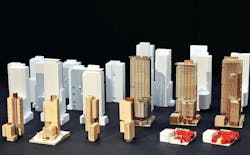Hackathons and RFCs: Why one developer killed the RFP
Lisa Picard is tired of the RFP process. As a seasoned real estate developer currently heading up one of Seattle’s most exciting new developments, Skanska Commercial Development’s 2&U tower, Picard has spent countless hours sifting through proposals for architectural services—feeling unimpressed.
The issue isn’t the caliber of the firms, nor the quality of the proposals. The problem, says Picard, is the overly formal nature of the RFP process for evaluating key partners.
“Why are we spending all this time and energy, having people spin their wheels and create volumes of paperwork, when really we just want to know if we can work together?” says Picard.
With Skanska acting as the developer, contractor, and financier on the 2&U project, Picard and her team had the freedom to try something different. They thought about hosting a design competition, but even then, do you really get a sense of how well the design partner will collaborate with the other team members, or deal with adversity? Hardly.
“Why are we spending all this time and energy, having people spin their wheels and create volumes of paperwork, when really we just want to know if we can work together?” — Lisa Picard, Skanska Commercial Development
Picard’s epiphany occurred on a Saturday afternoon, while walking through Skanska’s Seattle office. She came across a full-scale “hackathon” being hosted by a tech tenant in the building. The energy was infectious. The intensity was palpable. The level of creativity and collaboration was like nothing she had witnessed before. Could the hackathon model be adapted for a real estate project? “Why not? This is Seattle,” she says. “The idea of the hackathon is to break into something that works, but that you want to make better.”
Skanska scrapped the RFP for what Picard calls an “RFC,” or request for conversation. Nine firms were invited to join the builder/developer for individual 60-minute conversations—no formal presentation, no two-inch-thick portfolio, just a face-to-face to evaluate if the architecture firm was genuinely excited about the project, and if Skanska’s team would enjoy working with the design team. Much of the RFC centered around Skanska’s vision for the project, and its primary problem: how to create a world-class spec office tower that would both form a strong civic relationship with the city and connect downtown with the waterfront.
Two firms stood above the rest during the RFCs, but the true test was yet to come. Both were invited to participate in a three-week hackathon to test their grit, collaborative spirit, and mental endurance. (The firms were compensated for their time.)
Armed only with the developer’s vision and basic details on the project, the two teams set out the first week to develop their initial design solutions. To honor hackathon tradition, Skanska provided Red Bull for late-night design sessions. The firm also built into the program check-in points and feedback loops to reinforce the importance of collaboration and problem-solving among architect, developer, and builder.
In week two, just when the teams were starting to make headway on their design models, Picard changed the rules—removing a key parcel from the program—to see how the teams would respond. By the time the final presentations were delivered in week three, Picard says it was clear that one firm—Pickard Chilton of New Haven, Conn.—rallied when faced with adversity.
Picard says the hackathon was a success, and signals a shift in thinking among developers when it comes to selecting partners: it’s not just about IQ, but also EQ—emotional quotient. “Owners want partners who are as passionate about the project as they are,” she says. “You must express an energy that’s infectious. It has to be real.”
About the Author

David Barista
David Barista is Editorial Director of Building Design+Construction and BDCnetwork.com, properties that combined reach more than 100,000 commercial building professionals, including architects, engineers, contractors, and building owners. David has covered the U.S. construction industry for more than a decade, previously serving as Editor-in-Chief of BD+C, Professional Builder, Custom Builder, and HousingZone.com. He has won numerous editorial awards, including six Jesse H. Neal Awards and multiple honors from the Construction Writers Association and the American Society of Business Publication Editors.
Email: [email protected]
